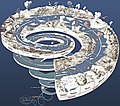File:Geological time spiral (de).jpg

Original file (2,416 × 2,144 pixels, file size: 3.54 MB, MIME type: image/jpeg)
Captions
Captions
Summary[edit]
| DescriptionGeological time spiral (de).jpg |
Deutsch: Ein Diagramm der geologischen Zeitskala English: A diagram of the geological time scale Esperanto: Diagramo montranta la geologian temposkalon Français : Diagramme montrant l'échelle des temps géologiques. |
| Date | September 2008 (Version 1.1) |
| Source |
This file was derived from: Geological time spiral.png: |
| Author |
|
| Other versions |
|
| This is a retouched picture, which means that it has been digitally altered from its original version. Modifications: Color and contrast enhanced for improved legibility; Cropping (multiple of 16 px); Retouching; Translation; Photoshop Saving options: Quality 12. Modifications made by MagentaGreen.
|
The Earth is very old—4.5 billion years or more according to scientific estimates. Most of the evidence for an ancient Earth is contained in the rocks that form the Earth's crust. The rock layers themselves—like pages in a long and complicated history—record the events of the past, and buried within them are the remains of life—the plants and animals that evolved from organic structures that existed 3 billion years ago.
Also contained in rocks once molten are radioactive elements whose isotopes provide Earth with an atomic clock. Within these rocks, "parent" isotopes decay at a predictable rate to form "daughter" isotopes. By determining the relative amounts of parent and daughter isotopes, the age of these rocks can be calculated. Thus, the scientific evidence from rock layers, from fossils, and from the ages of rocks as measured by atomic clocks attests to a very old Earth.
See USGS Fact Sheet 2007-3015 at http://pubs.usgs.gov/fs/2007/3015/ for ages of geologic time periods. Ages in the spiral have been rounded from the age estimates in the Fact Sheet. B.Y., billion years; M.Y., million years. For more information, see the booklet on Geologic Time at http://pubs.usgs.gov/gip/geotime/.
Licensing[edit]
| Public domainPublic domainfalsefalse |
This image is in the public domain in the United States because it only contains materials that originally came from the United States Geological Survey, an agency of the United States Department of the Interior. For more information, see the official USGS copyright policy.
Bahasa Indonesia ∙ català ∙ čeština ∙ Deutsch ∙ eesti ∙ English ∙ español ∙ français ∙ galego ∙ italiano ∙ Nederlands ∙ português ∙ polski ∙ sicilianu ∙ suomi ∙ Tiếng Việt ∙ Türkçe ∙ български ∙ македонски ∙ русский ∙ മലയാളം ∙ 한국어 ∙ 日本語 ∙ 中文 ∙ 中文(简体) ∙ 中文(繁體) ∙ العربية ∙ فارسی ∙ +/− |
File history
Click on a date/time to view the file as it appeared at that time.
| Date/Time | Thumbnail | Dimensions | User | Comment | |
|---|---|---|---|---|---|
| current | 08:50, 22 September 2016 |  | 2,416 × 2,144 (3.54 MB) | MagentaGreen (talk | contribs) | Beschriftung korrigiert |
| 11:21, 9 August 2016 |  | 2,416 × 2,144 (3.92 MB) | Gretarsson (talk | contribs) | das falsch im Paläozoikum platzierte NEOGEN durch KARBON ersetzt; Termini MISSISSIPPIUM und PENNSYLVANIUM ergänzt, da sich dies aufgrund einer bereits vorhandenen Zeitmarke im Karbon anbot | |
| 13:38, 7 August 2016 |  | 2,416 × 2,144 (3.86 MB) | MagentaGreen (talk | contribs) | == {{int:filedesc}} == {{Information |Description={{de|1=Ein Diagramm der geologischen Zeitskala}}{{en|1=A diagram of the geological time scale}}{{eo|1=Diagramo montranta la geologian temposkalon }}{{fr|Diagramme montrant l'... |
You cannot overwrite this file.
File usage on Commons
The following 3 pages use this file:
File usage on other wikis
The following other wikis use this file:
- Usage on cs.wikipedia.org
- Usage on de.wikipedia.org
- Usage on frr.wikipedia.org
- Usage on hu.wikipedia.org
- Usage on rm.wikipedia.org



